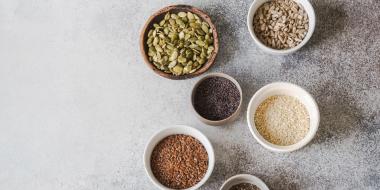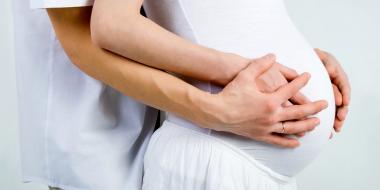If you are hoping to become pregnant in the near future, getting your vitamin D level checked might not be the first thing that occurs to you, but it’s an important component of your fertility health toolbox. This nutrient is commonly deficient in many people, and often the deficiency catches people by surprise, especially if they are the anti-sunscreen-outdoorsy type.
Vitamin D, skin, and sunshine
The journey with vitamin D starts with the skin. Unlike most vitamins, the primary source doesn’t come from the foods we eat — very few foods contain it naturally. It comes substantially from our exposure to the sun and ultraviolet B (UVB) rays. When the sunlight hits our skin, a cascade of chemical events occurs to produce vitamin D3, also known as cholecalciferol or calciol, from cholesterol. This form of vitamin D enters the blood to be processed by the liver and eventually the kidneys to make the most active form of vitamin D, called calcitriol. Deficiency can arise from anything that blocks UVB rays from interacting with the skin: wearing sunscreen or clothing, living in overcast climates or in places with short daylight periods, spending a lot of time indoors, or even having darker skin. A lot of people fall into one or more of these categories.
There is a fine balance between getting your vitamin D naturally by sunlight exposure and increasing your risk of developing skin cancer. When exposing yourself to UVB rays it is especially important to take care not to burn. Sunburn frequency and severity will increase your risk of developing skin cancer. This is why augmenting your vitamin D with a supplement can prove useful when weighing the risks of skin sun exposure to the benefits.
A very versatile vitamin
Vitamin D is known best for its role in bone health for both children and adults. But emerging research is showing that vitamin D has an effect on many other systems including our hormones, heart health, and immune system. Vitamin D deficiency is associated with colorectal cancer and breast cancer, but is also implicated in susceptibility to autoimmune diseases such as type 1 diabetes, multiple sclerosis, and systemic lupus. Research is also showing vitamin D is neuro-protective in the central nervous system and that chronically low vitamin D may be a precursor to cognitive decline as we age.
Vitamin D, baby!
A 2012 systematic review of vitamin D and fertility suggests improved clinical pregnancy rates in women receiving IVF and vitamin D supplementation, improved menstrual cycling in women with polycystic ovarian syndrome, and improved estrogen and progesterone production in healthy women. The same review showed vitamin D supplementation in men is positively associated with semen quality and testosterone production. Another review and meta-analysis published in 2018 in Human Reproduction showed that women undergoing fertility treatments and taking vitamin D had higher live birth rates than women who were vitamin D deficient or insufficient.
Vitamin D and reproductive health
Vitamin D also plays a big role in pregnancy and the health of both mama and developing baby. Women who are deficient in vitamin D during pregnancy have increased risk of developing gestational diabetes and preeclampsia. Gestational diabetes is a transient blood sugar disorder during pregnancy that can increase the lifelong risk of developing chronic type 2 diabetes in women. A baby born to a mom who developed gestational diabetes is at a higher risk of having excessive birth weight, low blood sugar at birth, and infant respiratory distress. This same baby also has an increased risk of becoming obese, and developing type 2 diabetes and cardiovascular disease later in life.
Preeclampsia is a dangerous and life-threatening form of elevated blood pressure that occurs in pregnancy and is often associated with gestational diabetes. Developing preeclampsia can result in a high-risk C-section birth. Preeclampsia is a leading cause of birth-related deaths in both mother and infant. And while there are more factors involved in developing gestational diabetes or preeclampsia than just being vitamin D deficient, it’s an easy way to reduce those risks.
Taking care of D business
To make sure your growing baby has enough vitamin D in utero, it is best to get your vitamin D in optimal order before you get pregnant. Your vitamin D level can be measured by a simple blood test. By conventional standards a vitamin D level less than 30 ng/mL is considered deficient. Clinically, I like to see levels between 50-100 ng/mL.
How much exposure to sunlight and UVB rays do you need to achieve this? Unfortunately, there is no standard prescription since sunlight exposure is affected by so many factors. (Try this online sun exposure calculator put out by the Norwegian Institute for Air Research to give you a ballpark idea.)
Aside from basking in the sun, you can increase your intake of fatty fish such as tuna, mackerel, and salmon, supplement with a high quality cod liver oil, and eat more foods fortified in vitamin D like organic dairy, orange juice, and cereal; I do recommend supplementing with vitamin D3 as a standalone supplement. In all my years practicing as a physician, I have rarely seen a healthy vitamin D level in anyone who is not adequately supplementing with vitamin D.
A dose of liquid sunshine
In Canada and the United States, the recommended daily allowance (RDA) of vitamin D is a meagre 400-800 IU depending on age and about as much a typical multivitamin or a prenatal vitamin will provide. That may be enough to ward off severe bone disease, but it is not enough for optimal health. When it comes to supplementing, I typically recommend anywhere between 2000-8000 IU per day depending on the severity of deficiency. If a person has a normal vitamin D level above 50 ng/mL, then I’ll have them take 2000 IU in the spring and summer and 4000 IU in the fall and winter. Vitamin D is a fat-soluble vitamin, meaning it will be best absorbed with food and will be stored for longer in your fat tissue. A supplement that is either a gel cap or a liquid will also have higher bioavailability compared to a powdered capsule or tablet. Yearly testing is highly recommended.
Theoretically you can get too much vitamin D, but toxicity, indicated by blood levels greater than 150 ng/mL and elevated calcium, is not commonly observed even with supplementation. According to the Vitamin D Council, toxicity can occur if you ingest greater than 40,000 IUs daily for 3 months. Vitamin D toxicity leads to high blood calcium and symptoms include increased thirst, loss of appetite, abdominal pain, muscle weakness or pain, bone pain, fatigue and confusion.
The benefits of vitamin D range from chronic disease prevention to fertility support. So get out in the sunlight and supplement with some liquid sunshine! Supporting your health and providing the building blocks for creating a healthy babe has many elements. This is just one nutrient to fill in the gaps where deficiency is common.
To further boost your preconception optimization, be sure to check out Part 1: Coenzyme Q10 for Fertility and Part 3: Omega-3 for Fertility of this series.






